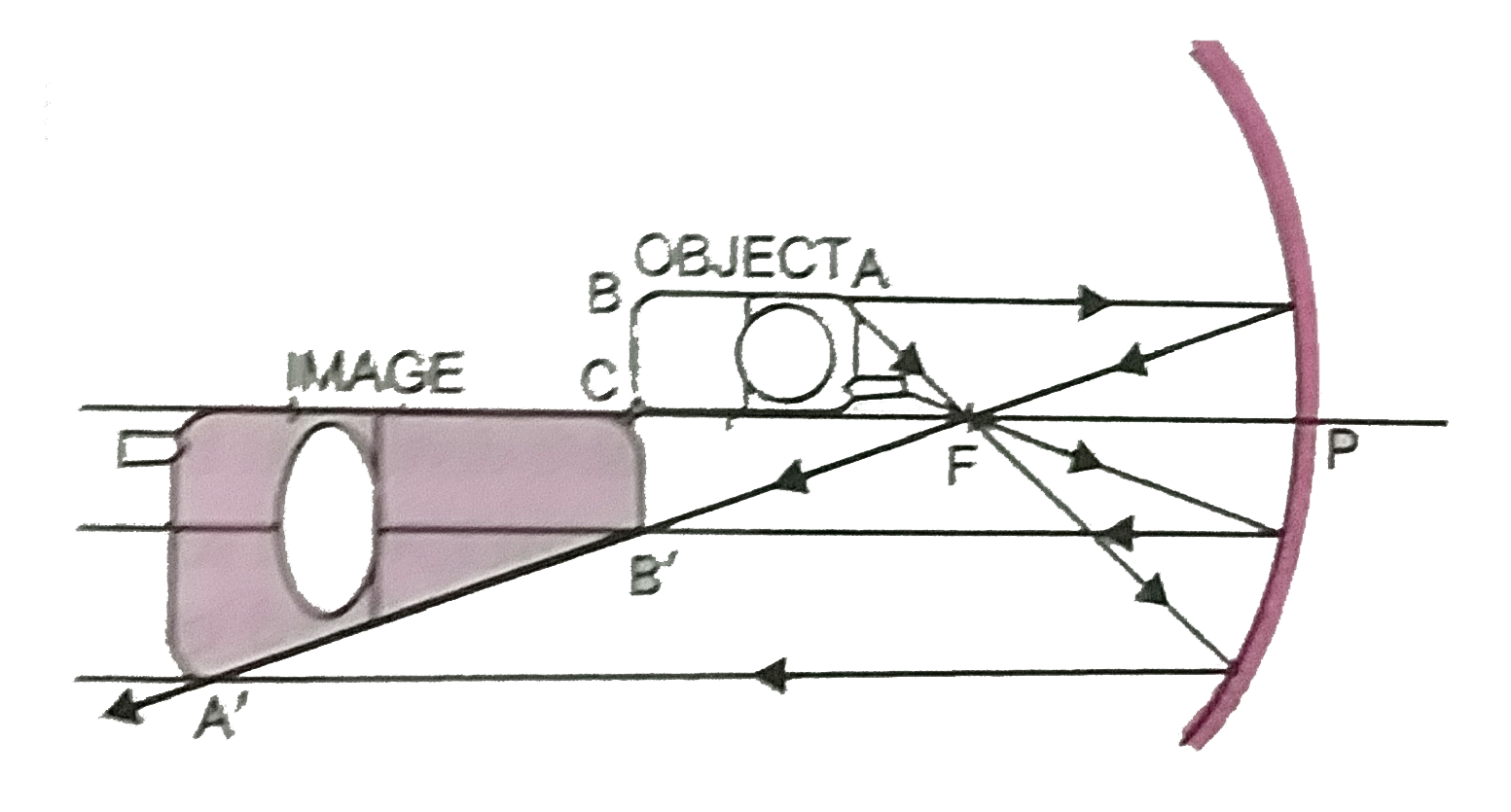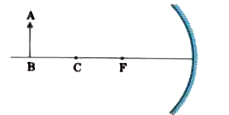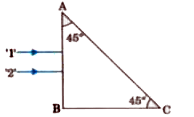Complete Solutions to Revision Exercises (Short Answer Questions) of chapter RAY OPTICS AND OPTICAL INSTRUMENTS of Class 12 book with complete answers and questions
| Class 12 | PHYSICS |
| Chapter | RAY OPTICS AND OPTICAL INSTRUMENTS |
| MODERN PUBLICATION | Revision Exercises (Short Answer Questions) |
| Number Of Questions | 43 |
| Academic Year | 2023-24 |
The relation between focal length `f` and radius of curvature `R` of a spherical mirror is.
View SolutionThe correct expression for refraction at single convex spherical surface separating two media of refractiv eindices `mu_(1) and mu_(2) ( mu_(2) gt mu_(1))` and radius of curvature R is ( u and v are object, image distane respectively )
View SolutionThe graph between `(1)/(v)` and `(1)/(u)` for a concave mirror looks like.
View SolutionA mobile phone lies along the principal axis of a concave mirror as shown in Fig. Show by suitable diagram, the formation of its image. Explain why the magnification is not uniform, and distortion will occur depending on the location of the mobile with respect to the mirror.

View SolutionAn object AB is kept in front of a concave mirror as shown in the figure.
(i) Complete the ray diagram showing the image formation of the object.
(ii) How will the position and intensity of the image be affected if the lower half of the mirror's reflecting surface is painted black ?

View SolutionState the expression for linear magnification of a concave mirror in terms of object distance and image distance.
View SolutionDefine refractive index of a transparent medium. A ray of light passes through a triangular prism. Plot a graph showing the variation of the angle of deviation with the angle of incidence.
View SolutionShow by drawing ray diagrams how a totally reflecting glass prism can be used to deviate a ray of light through (i) `90^(@)` (ii) `180^(@)` and invert it.
View SolutionRefractive index of glass is 1.5. Find the speed of light in glass and critical angle for glass.
View SolutionProve that `mu = (1)/(sin C)`' where `C` is the critical angle.
View SolutionWhat is total internal reflection ? What are its conditions ? Establish relationship between critical angle and refractive index.
View SolutionWhat is critical angle for a material of refractive index `sqrt(2)` ?
View SolutionWhat is optical fibre ? On what principle it works ? Give two application of optical fibres.
View SolutionExplain the term critical angle for a pair of media. Derive a relation between critical angle and refractive index of a denser medium with respect to a rarer medium.
View SolutionState the conditions under which total internal reflection occurs. One face of a prism with a refracting angle of `30^(@)` is coated with silver. A ray incident on another face at an angle of `45^(@)` is refracted and reflected from the silver coated face and retraces its path. Find the refractive index of the material of the prism.
View SolutionA symmetric biconvex lens of radius of curvature R and made of glass of refractive index 1.5, is placed on a layer of liquid placed on top of a plane mirror as shown in the figure. An optical needle with its tip on the principal axis of the lens is moved along the axis until its real, inverted image coincides with the needle itself. The distance of the needle from the lens is measured to be x. On removing the liquid layer and repeating the experiment, the distance is found to be y. Obtain the expression for the refractive index of the liquid in terms of x and y.

View SolutionObtain an expression for focal length of a combination of thin lenses in contact.
View SolutionTwo convex lenses of same focal length but of paerture `A_(1)` and `A_(2)(A_(2) lt A_(1))` are used as the objective lenses in two astronomical telescope having identical eye pieces. What is the ratio of their resolving power ? Which telescope will you prefer and why ? Give reason.
View SolutionDraw the schematic diagram of a Cassegrain telescope.
View SolutionDeduce the equivalent focal length of two convex lenses of focal lengths `F_(1) and F_(2)` when placed in contact.
View SolutionAn equiconvex lens of refractive index `mu_(1)`, focal length 'f' and radius of curvature 'R' is immersed in a liquid of refractive index `mu_(2)`. For (i) `mu_(2)gtmu_(1)`, and (ii) `mu_(2)ltmu_(1)`, draw the ray diagrams in the two cases when a beam of light coming parallel to the principal axis is incident on the lens. Also find the focal length of the lens in terms of the original focal length and the refractive index of the glass of the lens and that of the medium.
View SolutionThe image of a candle is formed by a convex lens on a screen. The lower half of the lens is painted black to make it completely opaque. Draw the ray diagram to show the image formation. How will this image be different from the one obtained when the lens is not painted black ?
View SolutionA figure divided into squares, each of size `1.0 mm^2` is being viewed at a distance of 9.0 cm through a magnifying lens of focal length 10 cm held close to the eye.
(i) The magnification produced by the lens will be
View SolutionTwo monochromatic rays of light are incident normally on the face AB of an isosceles right angled prism ABC. The refractive indices of the glass prism for the two rays '1' and '2' are respectively 1.35 and 1.45. Trace the path of these rays after entering through the prism.

View SolutionObtain an expression for the combined focal length for two thin convex lenses kept in contact and hence obtain an expression for the combined power of the combination of the lenses.
View Solutionलेंस समीकरण `(1)/(v) -(1)/(u) =(1)/(f)` की सहायता से दर्शाइए कि
अवतल लेंस से बना प्रतिबिम्ब सदैव आभासी व छोटा होता है |
View SolutionA ray of light falling at an angle of `50^@` is refracted through a prism and suffers minimum deviation. The angle of the prism is `60^@`. Find the angle of minimum deviation and refraction index of the material of the prism.
View SolutionHow does angle of deviation vary with the angle of incidence in case of prism ? What is the angle of minimum deviation?
View SolutionSky appears blue in colour. Explain.
View SolutionWhy does the sun appear red at sunset ?
View SolutionWhy does the Sun visible before the actual sunrise and sunset look reddish from the Earth ?
View SolutionWhy is there no dispersion of light refracted through a rectangular glass slab ?
View SolutionEye is more sensitive to yellow colour but danger signals are made with red colour. Why ?
View SolutionA convex lens of focal length 20 cm and a concave lens of focal length 10 cm are placed 20 cm apart. In between them an object placed at distance x from the convex lens.
What will be the linear magnification produced convex lens and concave lens individually ?
View SolutionWhat is hypermetropia (far-sightedness) ? What are its causes ? How can it be corrected ?
View SolutionCalculate the radius of the curvature an equi-concave lens refrective index 1.5, when it is kept in a medium refrecation index 1.4, to have a power of -5D ?
View SolutionAn equilateral glass prism has a refrective index 1.6 in air. Calculate the angle of minimum deviation of the prism, when kept in a medium of refractive index `4sqrt2/5`.
View SolutionWhat is astigmatism ? How can it be removed ?
View SolutionDraw a ray diagram for the formation of image by a compound microscope.
View SolutionObjective of a compound microscope should have small focal length. Why ?
View SolutionDraw a schematic ray diagram of reflecting telescope showing how rays coming from a distant object are received at the eye - piece . Write its two important advantage over a refracting telescope.
View Solutionअपवर्ती दूरदर्शी का नामांकित किरण आरेख खीचिए | इसकी आवर्धन क्षमता को परिभाषित कीजिए तथा इसके लिए व्यंजक लिखिए | परावर्ती दूरदर्शी की तुलना में अपवर्ती दूरदर्शी की दो सीमाएँ लिखिए |
View Solution(a) Show using a proper diagram how unpolarised light can be linearly polarised by reflection from a transparent glass surface.
(b) The figure shows a ray of light falling normally on. the face AB of an equilateral glass prism having refractive index 3/2, placed A in water of refractive index 4/3. Will this ray suffer total internal reflection on striking the face AC? Justify your answer.
View Solution
Revision Exercises (Short Answer Questions) questions and complete solutions for chapter RAY OPTICS AND OPTICAL INSTRUMENTS of MODERN PUBLISHERS PHYSICS (HINGLISH) of Class 12
All Exercises from MODERN PUBLICATION Class 12 PHYSICS RAY OPTICS AND OPTICAL INSTRUMENTS
- CHAPTER PRACTICE TEST
- Conceptual Questions
- Higher Order Thinking Skills & Advanced Level (QUESTIONS WITH ANSWERS)
- NCERT (EXemplar Problems Obejective Questions) (Multiple Choice Questions (Type-I)
- NCERT (EXemplar Problems Obejective Questions) (Multiple Choice Questions (Type-II)
- NCERT (Exemplar Problems Subjective Questions) (Very Short Answer Type Questions)
- NCERT FILE SOLVED (TEXT BOOK EXERCISES)
- OBJECTIVE TYPE QUESTIONS (A. MULTIPLE CHOICE QUESTIONS)
- OBJECTIVE TYPE QUESTIONS (ASSERTION REASON TYPE QUESTIONS)
- OBJECTIVE TYPE QUESTIONS (B. MULTIPLE CHOICE QUESTIONS)
- OBJECTIVE TYPE QUESTIONS (C. MULTIPLE CHOICE QUESTIONS)
- OBJECTIVE TYPE QUESTIONS (D. MULTIPLE CHOICE QUESTIONS)
- OBJECTIVE TYPE QUESTIONS (INTEGER TYPE QUESTIONS)
- OBJECTIVE TYPE QUESTIONS (JEE (ADVANCED) FOR IIT ENTRANCE)
- OBJECTIVE TYPE QUESTIONS (JEE (MAIN) & OTHER STATE BOARDS FOR ENGINEERING ENTRANCE)
- OBJECTIVE TYPE QUESTIONS (MATCHING TYPE QUESTIONS)
- OBJECTIVE TYPE QUESTIONS (MATRIX MATCH TYPE QUESTIONS)
- PRACTICE PROBLEMS (1)
- PRACTICE PROBLEMS (10)
- PRACTICE PROBLEMS (11)
- PRACTICE PROBLEMS (2)
- PRACTICE PROBLEMS (3)
- PRACTICE PROBLEMS (4)
- PRACTICE PROBLEMS (5)
- PRACTICE PROBLEMS (6)
- PRACTICE PROBLEMS (7)
- PRACTICE PROBLEMS (8)
- PRACTICE PROBLEMS (9)
- Revision Exercises (Additional Questions)
- Revision Exercises (Fill in the Blanks)
- Revision Exercises (Long Answer Questions)
- Revision Exercises (Numerical Problems)
- Revision Exercises (Short Answer Questions)
- Revision Exercises (Very Short Answer Questions)
- SOLVED EXAMPLES
- Tough & Tricky (PROBLEMS)